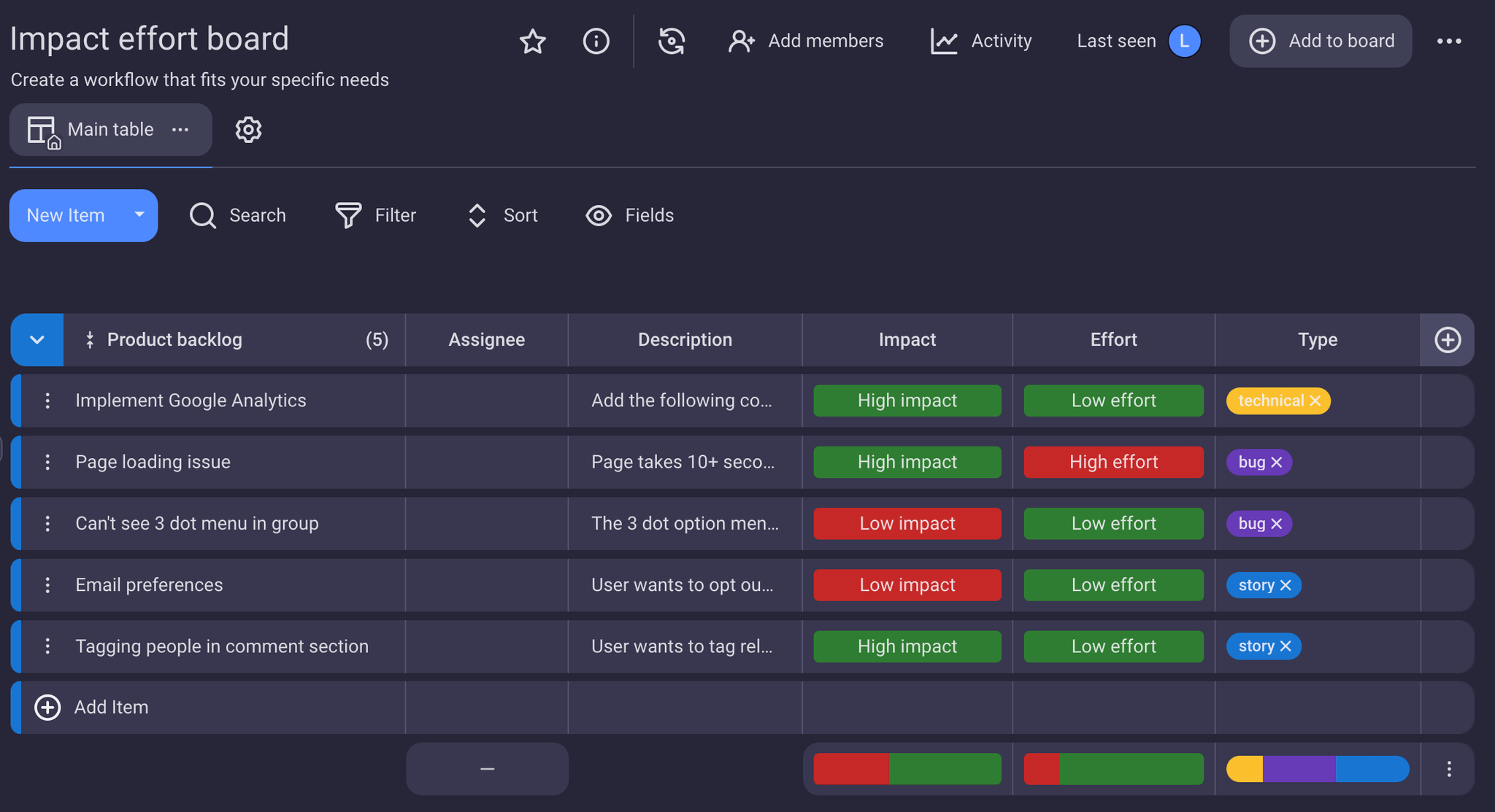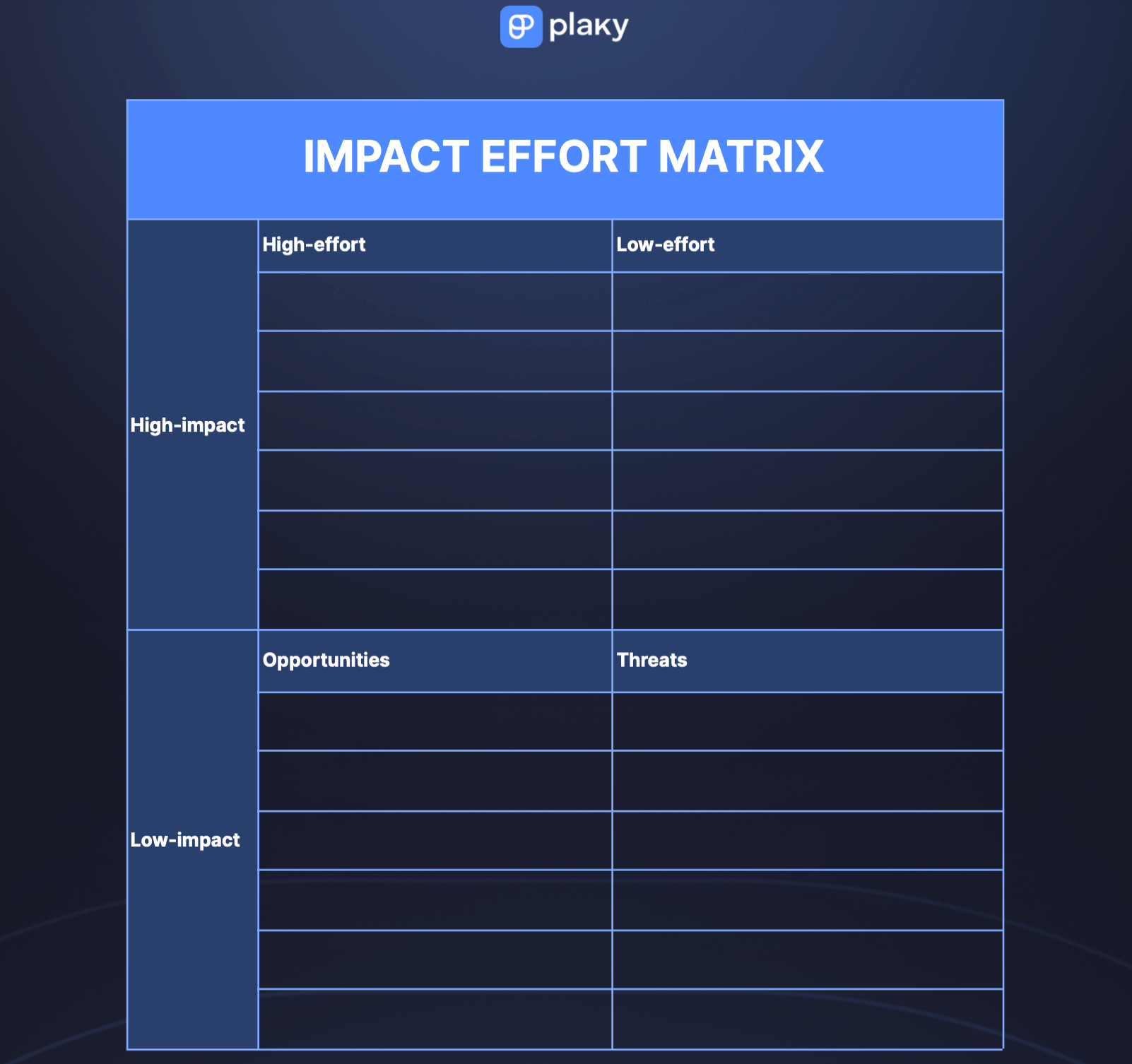While there are a lot of prioritization tools and techniques out there, one of the simpler yet incredibly effective ones is the impact effort matrix, also known as the action priority matrix.
In this text, I’ll walk you through everything you need to know about the impact effort matrix — what it looks like, how to make one, and when to use it — as well as provide free downloadable templates to help you get started with effective prioritization immediately.

- The impact effort matrix is a simple but effective prioritization tool that uses only 2 variables: impact and effort.
- High-impact, low-effort tasks should take the highest priority, followed by high-impact, high-effort ones.
- Don’t let low-impact, low-effort tasks tool you into doing them first just because they’re easy to do.
- The impact effort matrix is not a tool that should be used all the time because it disregards a lot of factors (like urgency) that can impact how you prioritize tasks.
In this article:
What is the impact effort matrix?
The impact effort matrix is a prioritization tool that rank-orders tasks using 2 variables:
- Impact — the magnitude of the benefits a task will bring upon completion, and
- Effort — how much resources (time, money, manpower, etc.) a task will require.
Both variables are further divided into high and low, bringing the overall number of categories in this matrix to 4:
- Low-effort, high-impact — tasks that will bring the most benefits for the least amount of time and resources. These tasks are also known as “easy wins” and should be given priority whenever they crop up.
- High-effort, high-impact — tasks that require a lot of resources, but also reward this investment in kind. “Major projects”, as they’re sometimes called, should be your focus most of the time, and should only be superseded by “easy wins”.
- Low-effort, low-impact — tasks that require few resources, but also don’t bring any substantial benefits. These “fill-in” tasks are perfect for, well, filling in blank spots in your schedule. Just be careful not to prioritize them above any of the high-impact tasks because of their “quick and easy” nature — they’re not worth it.
- High-effort, low-impact — tasks that offer horrendous “bang for your buck” — they will drain your resources without bringing proportional benefits. Also known as “thankless tasks” and “time-wasters”, these tasks should be altogether avoided if possible or, at the very least, bumped all the way down to the bottom of the priority list.
This is what an empty impact effort grid looks like.

How to use the impact effort matrix
Creating an impact effort matrix is quite simple and can be broken down into these 4 steps:
- Identify goals — the first requirement for prioritizing is knowing what your goals are. This means looking beyond the output you’re expected to produce and into the outcome it’s supposed to have.
- List out tasks — prioritizing an incomplete project task list is counterproductive, as you’ll have to revise item placements every time a task you forgot about gets brought up. On the other hand, if you’re a project manager prioritizing an entire project work breakdown structure, make sure to divide tasks into manageable groups. In Agile terms, you could prioritize the stories in each epic separately and tackle the project (and prioritization) one epic at a time.
- Assign impact and effort values to each task — next, simply decide whether each task ranks low or high along the impact and effort axes. Ideally, you’d get the project team together to do this, as their input will be invaluable when assigning the effort values to each task. The impact effort matrix doesn’t inherently rely on any method for this evaluation other than guesstimation, so, for the sake of accuracy, the people doing the work should be the people making the estimates.
- Prioritize accordingly — now all that’s left is to tackle the tasks in order: easy wins first, then major projects, followed by fill-ins. Avoid time-wasters if you can, if not, do them last. This is what a task list marked for impact and effort looks like in Plaky:

Traditionally, this prioritization process was done using a physical board, with post-it notes (or some approximation) serving as separate tasks.
The physical placement of a task could indicate higher effort or impact, even within the same category. This way, both the impact and the effort axes could serve as a spectrum ranging from low to high, rather than just binary descriptors.
Impact effort matrix template
Provided below is a simple Google Doc impact effort matrix template that you can use with minimal effort.
It’s essentially 4 tables arranged to mimic the layout of the 2×2 impact effort matrix.

Download: Google Docs | Google Sheets | Microsoft Excel | Microsoft Word | PDF
Why use the impact effort matrix
As a decision-making tool, the impact effort matrix is a simple way to ensure that you’re getting the best return on investment on the resources you put into a task.
In addition to task prioritization, the impact effort matrix is also useful when prioritizing projects. The process is entirely the same, just switch out “task” for “project” and you’re good to go. When prioritizing projects, you have more liberty to completely ignore the time-wasters.
To keep things simpler (and less wordy), I’ll refer to tasks in my explanations and examples.

When to use the impact effort matrix
Despite its simple nature, the impact effort matrix can be applied in a variety of situations. Here are some examples of when you should use this matrix to prioritize tasks or projects.
When you want to increase customer value and satisfaction
The impact side of the impact effort matrix invites you to put yourself in the customer’s shoes and evaluate tasks and projects based on the impact they will have on customer satisfaction, value, or experience. This, in turn, enables you to deliver more value to the customer through effective prioritization.
This may sound obvious, but tend to analyze tasks and projects from our perspective, asking questions like “how much time will this take,” or “how difficult will this be to implement,” without keeping the customer’s perspective in mind.
When you need to make the most of your resources
The fewer resources you have, the smarter you have to be about spending them. The impact effort matrix helps you get the best return on your investment by always pointing you in the direction of the most impactful tasks.
It’s also a great tool to turn to when projects have to be reevaluated after experiencing scope creep — here the matrix can help you decide which features to continue developing and which to give up on.
When you want to boost productivity and eliminate distractions
If a task is high-effort and low-impact, we naturally gravitate away from it. After all, who wants to work hard for little benefit?
However, tasks that are both low-effort and low-impact are deceptively dangerous. I like to call these tasks distractions — it’s the “it’ll only take a minute” situation you’ve likely found yourself in when you’re working on something more important.
Add the planning fallacy — the phenomenon that states that we are likely to both underestimate time and overestimate our abilities — and you can see how even tasks that should be low-effort can easily end up taking much longer than we initially estimated.
When you want to align team members toward a shared goal
The impact effort matrix forces you to explicitly state what your goals are and then find ways of achieving them through prioritization.
Provided the whole team is part of this process, it means that everyone will be on the same page regarding what’s important and how to prioritize it, which helps in avoiding implicit project assumptions and prevents the project risks associated with them.
When you need to fix a concrete problem
You can easily interpret the impact axis of this matrix as denoting “does this fix my problem”.
High-impact items (be they tasks, projects, or anything else) do fix your problem, low-impact ones don’t.
Then it’s only a matter of ordering the high-impact solutions according to effort. This is a pragmatic approach to both fixing issues mid-project, choosing projects, or even addressing issues in your personal life.

When not to use the impact effort matrix
For all its benefits, the impact effort matrix is not a one-size-fits-all solution to every task management or prioritization challenge you may face.
For starters, it only uses 2 variables, and these variables won’t (and shouldn’t) be the determining factors whenever you prioritize anything.
Sometimes, you’ll also want to take urgency into account, in which case the Eisenhower matrix, which evaluates tasks based on urgency and importance, is more useful.
The impact effort matrix is also more useful for organizations when deciding between different projects or teams when prioritizing tasks or features than it is for individuals when going about their day-to-day jobs.
Prioritize tasks with Plaky
Another downside to using the impact effort matrix (or at least the physical version or a Google Docs template) is that it leaves your workflow documentation scattered across multiple sources.
One way to avoid this is to use task management software like Plaky to manage your entire workload, prioritization included.
In Plaky, you can make custom statuses for any task and sort all tasks in a given category according to these statuses. This will enable you to keep track of task effort and impact values at a glance, in addition to all the regular perks that Plaky offers, such as:
- Unlimited users, boards, spaces, and items, with custom fields,
- In-task communication with @mentioning and notifications,
- Table, Kanban, and Gantt views,
- Sort and filter options, activity log, and summary rows,
- Google and Apple SSO,
- 24/7 support, and more.
To simplify prioritization and keep all your task and project information on one centralized platform, get started with Plaky for free now.

